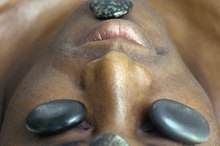The Difference Between Myofascial Release & Massage Therapy
Massage therapy can be traced back to the days of Hippocrates. More recently, physical therapist John Barnes took deep tissue -- or myofascial -- massage and transformed it into myofascial release. From reducing stress to eliminating chronic pain, these therapies are based on manual manipulation of the body. Although similar in these respects, distinct differences exist between the two.
If you are experiencing serious medical symptoms, seek emergency treatment immediately.
Focus
Massage therapy focuses on the body's soft tissue and musculature. Its goal is to alleviate tension and stress through touch and manipulation of the tissues. Myofascial release works the connective tissue, or fascia. Gentle pressure is applied to loosen the tightness in the fascia believed to cause muscle restrictions. Back pain and a decrease in range of motion are common complaints of myofascial release patients.
- Massage therapy focuses on the body's soft tissue and musculature.
- Myofascial release works the connective tissue, or fascia.
Time
Cold Stone Massage
Learn More
While massage therapy features kneading and stroking to relax the muscles, myofascial release uses sustained pressure to stretch and lengthen the connective tissue. Several minutes of this pressure may be required to properly soften and align the fascia.
Lubricants
A significant difference between the two therapies is the use of lubricants. Massage treatments often use oils or lotions to prevent friction between the therapist and the patient's skin. Myofascial release uses no lubricants. This therapy seeks to manipulate the fibers of the fascia to straighten and soften them. Lubrication prevents the practitioner from accurately finding the restrictions and getting a good hold on the fibers.
- A significant difference between the two therapies is the use of lubricants.
- This therapy seeks to manipulate the fibers of the fascia to straighten and soften them.
Benefits
How Chinese Massage Might Help With Muscle and Joint Pain
Learn More
The effects of massage therapy are generally temporary, while some proponents of myofascial release believe it can eliminate chronic conditions. The Mayo Clinic points out the lack of scientific proof that the effects are long-term but acknowledges it may relieve acute pain. According to the University of Maryland Medical Center, studies have shown massage to be beneficial for children suffering from autism, cystic fibrosis and attention-deficit hyperactivity disorder 1. Patients with pain or loss of motion from injuries, surgery, bad posture or trauma have found myofascial release beneficial.
- The effects of massage therapy are generally temporary, while some proponents of myofascial release believe it can eliminate chronic conditions.
Related Articles
References
- University of Maryland Medical Center; Massage; Steven D. Ehrlich
- Castro-Sanchez AM, et al. Benefits of massage-myofascial release therapy on pain, anxiety, quality of sleep, depression, and quality of life in patients with fibromyalgia. Evidence-Based Complementary and Alternative Medicine: eCAM. 2011;2011:561753.
- Ceda D, Elvira L, Guzman JF, Pablos A. Benefits of a self-myofascial release program on health-related quality of life in people with fibromyalgia: a randomized controlled trial. Journal of sports medicine and physical fitness. 2017;57(7-8):993-1002. doi:10.23736/S0022-4707
- Kain J, et al. Comparison of an indirect tri-planar myofascial release (MFR) technique and a hot pack for increasing range of motion. Journal of Bodywork and Movement Therapies. 2011;15(1):63-7.
- Liptan GL. Fascia: A missing link in our understanding of the pathology of fibromyalgia. Journal of Bodywork and Movement Therapies. 2010;14(1):3-12.
- Meltzer KR, et al. In vitro modeling of repetitive motion injury and myofascial release. Journal of Bodywork and Movement Therapies. 2010;14(2):162-71.
Writer Bio
Kathy Mair has been writing professionally since 1994. As a member of the Kinston Indians front office, she was responsible for all team press releases and articles, a duty she subsequently held for two other minor league baseball teams. Mair also spent time as a copy editor for "TV Guide." She holds a Bachelor of Arts in communications from Elizabethtown College.








